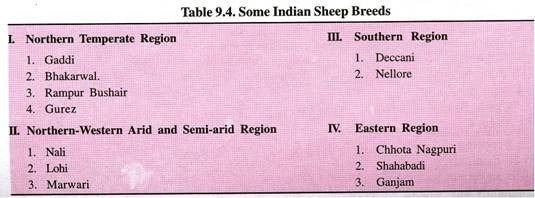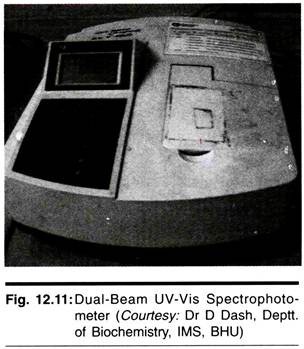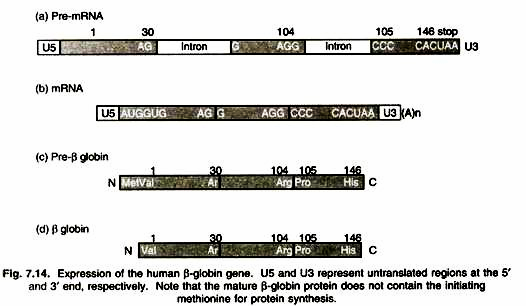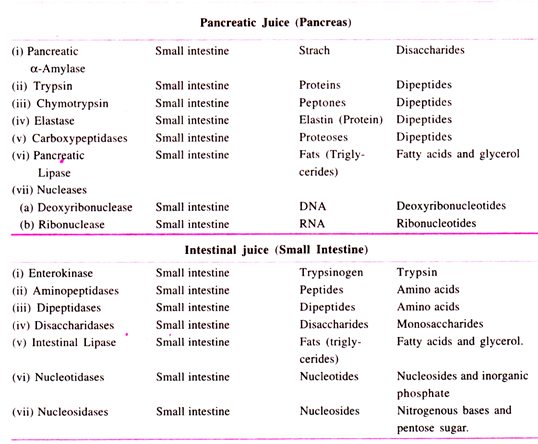In this article we will discuss about:- 1. Digestion of Carbohydrates 2. Digestion of Proteins 3. Fats 4. Nucleic Acids 5. Neural Regulation.
Digestion of Carbohydrates:
Carbohydrates are of three kinds— polysaccharides, disaccharides, and monosaccharide’s Polysaccharides and disaccharides are broken down to monosaccharide’s during the process of digestion, Starch and cellulose are polysaccharides that are present in cereal grains, potato, tubers and fruits.
Sucrose (in cane sugar), maltose (in malta), and lactose (in milk) are disaccharides. Enzymes which act on carbohydrates are called carbohydrates.
1. Digestion of Carbohydrates in the Oral Cavity:
Action of Saliva:
In oral cavity, the food is mixed with saliva. The saliva contains an enzyme called salivary amylase (ptyalin) which converts starch into maltose, isomaltose and small dextrins called α-dextrins. About 30 percent of starch is hydrolysed in the oral cavity. Lysozyme present in saliva acts as an antibacterial enzyme.
Bio-carbonate ions in saliva neutralize the acids in food. The thiocyanate ions of saliva act as antimicrobial agent and prevent infection by the microbes that often enter along with food. Mucus of the saliva moistens and dissolves some of the food and lubricates the oesophagus.
Salivary amylase is absent in the saliva of many herbivorous mammals like cows and buffaloes and predatory carnivorous mammals like lions and tigers. However, saliva of pigs contains salivary amylase. The gastric juice also contains small amount of gastric amylase but its action is inhibited by the highly acidic condition.
2. Digestion of Carbohydrates in the small intestine:
In response to the action of stimuli received from the vagus nerve (10th carnial nerve) and secretin (a gastrointestinal hormone), the Brunner’s gland (compound tubular glands of the duodenal epithelium) secretes a large amount of viscous, enzyme-free, alkaline and watery mucoid fluid.
This secretion enables the duodenum to withstand the acidic chymes entering from the stomach, until it is neutralized by the alkaline pancreatic juice and bile. The mucus is secreted by the goblet (mucous) cells, where as water and electrolytes are secreted by the enterocytes present on the intestinal crypts.
The mucus protects the duodenal wall from getting digested. Digestion of most of the nutrients takes place in the duodenum under the action of various enzymes.
(i) Action of Pancreatic Juice:
The pancreatic juice contains starch digesting enzyme, called pancreatic a-amylase which converts starch into maltose, isomaltose and α-dextrins. Bicarbonte of the pancreatic juice neutralises hydrochloric acid of the chyme (semifluid mass) that enters the duodenum.
(ii) Action of Intestinal Juice:
Intestinal juice contains maltase, isomaltase, sucrase (invertase), lactase and α- Dextrinase which act as follows:
Lactose Intolerance:
Only human being can digest lactose present in the milk, but with advancing age, they produce little or no lactase. In such persons, the lactose of milk remains undigested and is fermented in the intestine producing gases and acids.
This results in flatulence, intestinal cramps and diarrhoea. So these persons should take yoghurt or curd as lactose is fermented into lactic acid in them. This does not pose any digestive problem to them.
Digestion of Proteins:
Proteins are made up of amino acids. So proteins are broken down to amino acids during the process of digestion. Enzymes that hydrolyse proteins are called proteases or peptidases.
Many of these enzymes are secreted in their inactive forms called pro-enzymes as their active forms would hydrolyse cellular and extracellular proteins of organisms itself. Inactive forms of enzymes are converted to their active forms at the sites of their actions.
Saliva does not contain any protein digesting enzyme. So digestion of proteins does not occur in the oral cavity. However, saliva can denature the uncooked natural proteins such as that present in raw egg, un-boiled milk or uncooked germinating seeds.
1. Digestion of Proteins in the Stomach:
Action of Gastric Juice:
The stomach normally stores the food for 4-5 hours. The gastric glands of the stomach secrete gastric juice. It contains hydrochloric acid, pro-enzymes— pepsinogen and pro-rennin. Hydrochloric acid maintains a strongly acidic pH of about 1.5 to 2.5 in the stomach. pH of infants’ gastric juice is 5.0. HCI kills bacteria and other harmful organisms that may be present along with food.
HCI converts pepsinogen and pro-rennin into pepsin and rennin respectively. Once pepsin is formed it changes pepsinogen into pepsin. Such an activation is called autocatalytic reaction. Pepsin and rennin are absent in invertebrates. Gastric juice is thoroughly mixed with food until it becomes a semifluid mass called chyme.
Various reactions are summarized below:
Functions of Hydrochloric Acid:
Hydrochloric acid serves the following functions:
(i) It kills harmful bacteria.
(ii) It provides acidic medium in the stomach for gastric digestion.
(iii) It changes pepsinogen into pepsin and pro-rennin into rennin.
(iv) It softens the food and dissolves the cement materials between the cells of the food in order to make them readily available for enzyme action.
(v) It stops the action of salivary enzyme.
(vi) It is believed to control the opening and closing of pyloric opening of the stomach.
2. Digestion of Proteins in the small intestine:
(i) Action of Pancreatic Juice:
Pancreatic juice contains pro-enzymes— trypsinogen, chymotrypsinogen and procarboxypeptidase and enzyme elastase. All these are concerned with proteins digestion. The bile provides alkaline medium for various reactions.
All these reactions are summarised below:
Pro-tine, per-tones and pro-teoses are acted upon as given below:
In predatory animals, trypsin can hydrolyse fibrinogen of blood into fibrin leading to blood coagulation. Mostly vertebrates do not have proteases for digesting some fibrous animal proteins such as hair, keratin, silk fibroin and wool protein. However, some invertebrates like insects secrete enzymes for digesting such fibrous proteins. Therefore, some insects destroy silk fabrics and woollen garments.
(ii) Action of Intestinal Juice:
Intestinal juice (succus entericus) contains enterokinase (enteropeptidase)- also called “activator enzyme”, amino peptidases and dipeptidases. Enterokinase converts trypsinogen of pancreatic juice into trypsin. Actions of other enzymes are summarized below:
Digestion of Fats:
Almost the entire fat portion of the diet consists of triglycerides (neutral fats) which are made up of three fatty acid molecules and a single glycerol molecule. In fact glyceride is an ester of glycerol compounded with an acid.
There are present mono-, di- and triglycerides. Steapsin or fat digesting enzymes are soluble in water, but insoluble in fats and oils. However, fats and oils are insoluble in water. Term lipase is usually used as fat digestive enzyme.
Saliva contains no lipase. The stomach also lacks any fat-emulsifying agent. However, the gastric juice contains small amount of gastric lipase which converts some fats into monoglycerides and fatty acids. Fat is largely digested in the small intestine. Bile salts of the bile break down fat droplets into many small ones by reducing the surface tension of fat droplets. This process is called emulsification.
This increases lipase action on fat. Lipase is present in the pancreatic juice and intestinal juice. Pancreatic lipase is the principal enzyme for the digestion of fat. In addition, an intestinal lipase is also helpful in the digestion of fat.
The pancreatic lipase converts emulsified fats (triglyceride fats), first into diglycerides and then into monoglycerides, releasing a fatty acid at each step. The intestinal lipase converts remaining fats into monoglycerides and fatty acids. Finally all fats are converted into fatty acids, glycerol and monoglycerides.
Lipase is activated by the bile.
Digestion of Nucleic Acids:
Nucleic acids are digested in the small intestine. The enzymes which digest nucleic acids are present in the pancreatic juice and intestinal juice.
(a) Pancreatic juice:
It contains two nucleases: Deoxyribonuclease (DNase) and Ribonuclease (RNase), which act as follows:
(b) Intestinal juice:
It contains enzymes; nucleotidases and nucleosidases which act as under.
Chyle:
It is a white or pale yellow fluid taken up by the lacteals (lymph capillaries) from the intestine during digestion. It mainly consists of absorbed fat.
Neural Regulation of Digestion:
The activities of the gastro-intestinal tract are under neural and hormonal control for proper coordination amongst different parts. The gastrointestinal tract is innervated by an intrinsic nervous system as well as by extrinsic nerves.
The intrinsic neural system is also called, the enteric neural system, consists of (i) the Meissner’s plexus situated in the sub-mucosa and (ii) the Auerbach’s plexus situated in the muscular layer. The enteric neural system controls most of the gastrointestinal functions like secretion and motility.
The extrinsic innervation of the gut consists of parasympathetic and sympathetic nerves which can modify the activity of the intrinsic neural system in response to reflex activity initiated from the GIT itself or from other parts of the body.
The sight, smell and presence of food in the gastrointestinal tract act as a stimuli for the secretion of saliva. This happens by the stimulation of vagus nerve. Feeling of hunger at a particular time, when regularly food is taken, is an example of conditional reflex.









